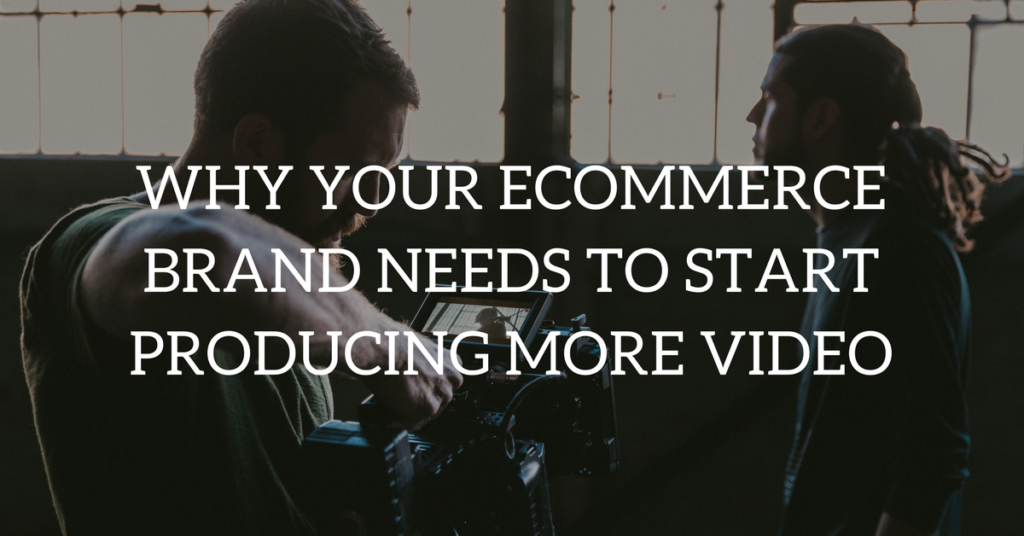In 2017, more brands created and shared video content than ever before. In ecommerce, competition for the attention of online consumers is fiercer than ever. As more and more companies have started to implement the same tired social media, content marketing, and digital marketing strategies and tactics as their competitors, the smartest and most innovative ecommerce brands have started looking for new ways to build brand awareness, increase traffic, and convert customers. Many are turning to video.
To really understand the prevalence, popularity, and potential value of video creation for brands today, consider these staggering statistics from WordStream and Buffer:
- 72 Hours of video are uploaded to YouTube every 60 seconds.
- 45% of people watch more than an hour of Facebook or YouTube videos a week.
- More video content is uploaded in 30 days than the major U.S. television networks have created in 30 years.
- Video on a landing page can increase conversions by 80% or more.
- Viewers retain 95% of a message when they watch it in a video compared to 10% when reading it in text.
- Online videos will account for more than 80% of all consumer internet traffic by 2020.
- 55% of people consume videos thoroughly — the highest amount all types of content.
- Companies that incorporate videos in their marketing strategy experience a 27% higher CTR and a 34% higher web conversion rates than those that don’t.
Needless to say, video presents a pretty big opportunity for brands looking to get more return from their marketing budgets in 2018.
This post will help you understand why you should be creating more video for your ecommerce brand, offer a handful examples of the types of videos you could be producing, and provide you with actionable tips on how to get started.
The Case for More Video
Video continues to grow in popularity among brands looking to make a bigger impact and get more return from their online marketing efforts. In fact, according to Buffer, “83% of marketers say they’d create more video content if there were no obstacles like time, resources, and budget.”
So the question is, why are brands turning to video more than other types of content? We’ve looked at some of the more quantifiable opportunities that video marketing presents for ecommerce brands, but what about some of the less tangible benefits?
Here are some ideas:
Video Builds Trust — These days, consumers are more than ever looking to buy products from transparent, humanized brands. As I’ve mentioned numerous times on this blog, you don’t have the opportunity to meet your customers face-to-face in ecommerce. As a result, it’s harder to form connections and nurture relationships with the people who are interested in buying from you. Video helps solve this problem. It gives you, the business owner, the opportunity to get in front of the camera and actually talk to your current and prospective customers. You can now even interact with them in real-time, thanks to the introduction and popularity livestreaming video tools like Facebook Live. Ecommerce has come a long way in the past 5-10 years, but online consumers are still wary of giving their money and personal information to a business they do not know well. Use video to convince them that there are real, caring humans running the show.
Video Makes it Easier to Differentiate — It’s never been easier to spin up an ecommerce store. Every day, there are new entrepreneurs trying to start businesses and sell products based on the success of other people. It’s a great time to be an ecommerce business owner, but it’s also incredibly challenging at times. Competition is fierce, and you need to constantly be thinking of new ways to stand out. Video helps you do that. It allows you to create original content that other people can’t easily replicate on their own websites. It shows your audience that you actually have personality, and that you genuinely care about the industry you’re in and the people you’re serving.
Video Helps You Reach More People — More people are watching videos online than ever before, so if you want to capture new leads and attract new customers, this seems like the best way to do it right now. According to Buffer, “over 8 billion videos or 100 million hours of videos are watched on Facebook every day.” The traditional text-based and photo-based social media updates just aren’t as effective as they used to be on sites like Facebook and Twitter—but video is.
Video Can Create More Conversations — Because more people are watching videos on social media sites, they are also sharing and talking about video more with their friends. As ecommerce brands have started to experience less reach and engagement on their social media updates that leverage text and photos, many are turning to video to get people talking again.
Video Forces You to Be Creative — Creating good video takes a lot of work! It requires a lot of creativity and skill. The downside of this type of content is that you have to spend more time and resources producing it, but the upside (as I mentioned earlier), is that it’s harder for others to steal! Anyone can read a blog post and rip the information in it. But it’s much harder to steal or repurpose an original video. Video forces you to be creative, but it also helps you create content that people can’t rip off and benefit from on their own websites and social media pages.
Video Can be Repurposed in Many Ways — When you producing a video, you’re usually creating a lot of content that can be repurposed in other ways. As a marketer, your goal should always be to create amazing content that can be cut up and repackaged in different ways and for different channels and audiences. Think of the repurposing potential of a 2-minute video you create for your business. The footage can be spliced into 15 second ads, the script can be worked into an email campaign, blog post, or social media updates. The value and return you get on one piece of video is tenfold.
Now that you know the why of video, where do you go from here? How do you incorporate more video into your marketing strategy going forward? The next best step to take is to think about the types of videos you ultimately want to create and share for your ecommerce business.
Types of Video You Could be Producing
When it comes to creating different types of video, the possibilities are essentially limitless. It all comes down to what your goals are, who your audience is, and how creative you can be. For the purposes of this article however, I am recommending 6 types of videos that you can experiment with creating first:
1. Product Promotion Videos: The first type is perhaps the most obvious—the product promotion video. With these types of video, your goal is to essentially demo and showcase your product for your prospective customers. How creative you get with the video is entirely up to you. You could simply show close-up footage of your product with a simple music track attached, or you could enlist the help of a raving fan or influencer to showcase your product for you. These are the types of videos that help you build trust with your audience and make it easier for your almost-customers to overcome any objections they might have about buying your products.
With these video types fresh in your mind, it’s time to start thinking about how to approach creating your very first video.
How to Get Started with Video
You now know the potential value that video could bring to your ecommerce business, and you know the types of videos you could be creating—you’re officially ready to make your first video.
To ensure that you’re successful in your first attempt, follow these 6 recommended steps:
Step 1: Think About Your Audience — Before you decide on the type of video you want to produce, it’s important to think about your audience. The purpose of creating a video for your ecommerce business is not to say that you did—it’s to serve your customer and prospective customer. In order to decide on a video that would ultimately lead them closer toward conversion, ask yourself these questions:
- Who is my customer? What do they care about?
- What problems do they have? How can I help?
- What questions are they regularly asking me?
- What prevents people from buying from me?
- What convinces people to buy from me?
- What information can I share with them about my business or products that they aren’t getting right now?
- What type of video do I think my customers would want to see most?
The answers to these questions will help you move forward with the right video idea.
Step 2: Develop a Few Ideas — The second step in the process is to develop a few specific ideas. To do this, start by evaluating the video types mentioned earlier in this post. Find a few you like, then jot down 2-3 ideas of specific videos you think you could create that fall underneath the video types you chose. Remember: your ultimate goal is to create valuable content that helps your customer in their decision-making process. For you, that might mean creating a video that tells the story about your business and your products. Or it might simply be a video that highlights the main benefits and features of your products. When you have a handful of ideas written down, try to narrow it down to just one.
Step 3: Buy Equipment or Hire an Expert — When you’re finally ready to create your video, there are two options you can take: you can either buy or rent video equipment and take on the task yourself, or you can hire an expert. If you want to try to shoot the video yourself, refer to this resource—it will help you pick the right equipment for your video. If you’d rather hire the task out but you don’t want to spend a fortune, put an ad or flyer out at the local college in your area. Find a videography student who is hungry to get more experience.
Step 4: Create a Promotion Plan — Before you start shooting your video, you should also think about the promotion plan you want to put in place once your video is ready to share. Ask yourself these questions:
- What is the purpose and goal of this video? Where is it ultimately going? Is it intended for my website? For my social media pages? For an upcoming email campaign? For a new blog post?
- Where are all the places I could share it?
- Where are the places it would be most effective?
- What else will I need in order to make the promotion of this video successful (ad spend budget, blog graphics, a custom email campaign, etc).
Knowing the answers to these questions will help you plan ahead and ensure that you’re getting the most value out of the time and money you spend creating your video. When you have your promotion plan in place, you’re ready to start work on your video.
Step 5: Shoot, Edit, Export — Record your video, edit it, then export it as different formats and for different locations. You may need different size files depending on where you upload it (your website, your Facebook page, your YouTube channel, etc). Again, if you’re not comfortable doing this work yourself, find an expert who can help.
Step 6: Publish, Promote, Repurpose — When you’re finally ready to share your video, upload it to the channels you chose, and start executing on your promotion plan. As you watch for engagement from your followers, customers, and prospects, start making plans for repurposing the content in your video. Remember: your goal is to get as much out of your video as possible.
Over to You
Have you been creating more video for your ecommerce business recently? What has your experience been so far? Tell me in the comments below.


